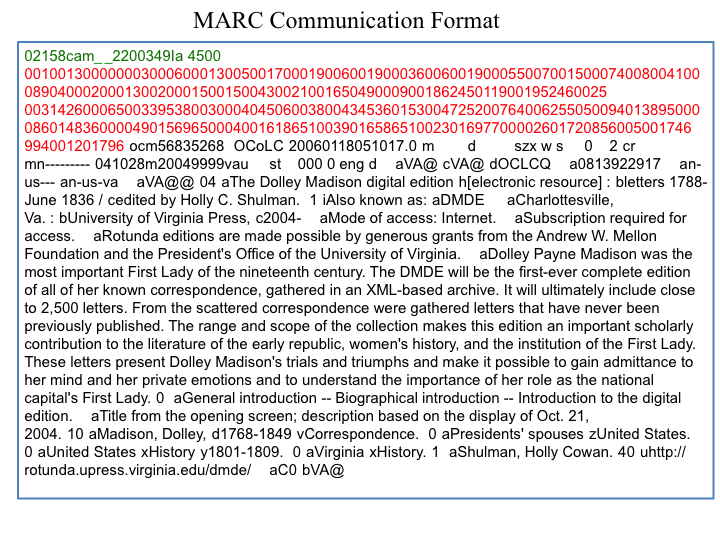Leader
The leader identifies the beginning of a new record and provides coded information for record processing. The leader is fixed in length and contains 24 characters. The leader contains, among others, character positions for record length, type of record (e.g., language-based material, cartographic material, etc.), and bibliographic level/mode of issuance (e.g., monograph, serial, integrating resource). Many of the elements in the leader are system-generated data. The first information presented in
the leader is that the record is 2,158 characters long. This
information is followed by characters in fixed positions that give
specific coded information.
Directory
The directory is divided into segments of 12
characters each. These divisions can be seen in the image below.

There are as many 12-character segments as there are
fields in the rest of the record. The first three characters of each
12-character segment are the MARC tag for the field represented (e.g., 001). The
next 4 characters tell the length (number of characters) of the field
represented (e.g., 0013). The last five characters tell the starting position for
that field in the portion of the record that follows the directory (e.g., 00000).
For example, the second segment of the directory above tells that the
008 field has 41 characters and starts at position 00013 in the record
immediately after the information in the 001 field; the third segment tells that the 005 field has 17 characters and starts at
position 00054; and so on.
The directory allows a programmer to write a
program for display that essentially says to the computer: go to
position 00000 [or 00013, or 00054, etc.], get the next 13 [or 41,
or 17, etc.] characters, go to the display and place those
characters at position x, label this field "LCCN" [or "Fixed
field data," or "Date/time," etc.].
Content fields
The content fields in MARC are many and diverse. They consist of control fields, number and code fields, classification fields, and variable data fields.
Control fields always begin with two zeros (00X). Control fields carry alphanumeric (often encoded) data elements. Included is the 008, often known as "the fixed field." Field 008 carries general information about the content of the bibliographic record. This field is sometimes displayed in a single paragraph at the top of the screen and is often displayed with mnemonic tags. In other displays, it may appear as a single 40-character long text string with intermittent blanks.
The fixed field as displayed in an OCLC MARC record:

The fixed field as displayed in the LC catalog:
008 150616s2015 cau b 001 0 eng
Number and Code fields (010-049) contain a variety of types of information. Some of the more common fields include the 010 field, which contains unique control numbers assigned to MARC records by LC, and the 016 field, which is similar but for control numbers assigned by other national libraries or agencies. ISBNs and ISSNs are recorded in the 020 and 022 fields respectively.
Classification Notations and Call Numbers fields (055-099) include both full call numbers, including shelf marks, as well as partial call numbers including only classification notations proper. These fields are used by both national-level and local cataloging agencies.
Variable Data fields (100-88X) carry alphanumeric data of variable length. The variable fields carry traditional cataloging data elements.
On the next page, we will look at the major pieces of a MARC data field.


